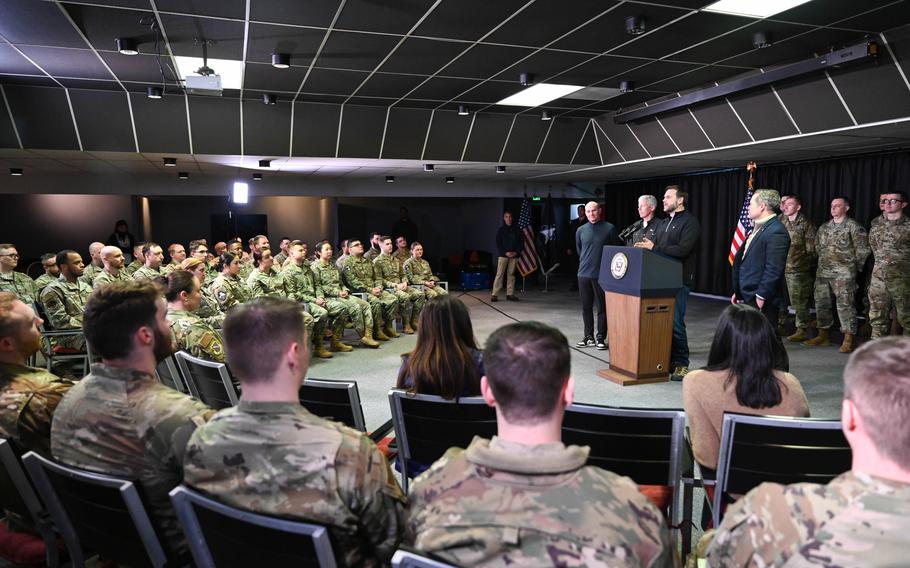
Vice President JD Vance meets with guardians and airmen stationed at Pituffik Space Base in Greenland on March 28, 2025. During the visit, Vance addressed the importance of the U.S. military’s northernmost installation . (U.S. Space Force)
U.S. Northern Command will now oversee American military troops and operations in Greenland, which has long been the responsibility of U.S. European Command, the Pentagon announced Tuesday.
The move comes as President Donald Trump has long mused about taking control of the island, which he has argued is critical to U.S. national security and protecting its Arctic interests. Trump ordered the change under a biennial review of the Unified Command Plan, which organizes the responsibilities for each of the Pentagon’s geographic combatant commands, Sean Parnell, the Pentagon’s chief spokesman, said in a statement.
“This change will strengthen the joint force’s ability to defend the U.S. homeland, contributing to a more robust defense of the Western Hemisphere and deepening relationships with Arctic allies and partners,” Parnell said.
While largely symbolic, the change appears to signal the Trump administration’s intentions of portraying control of Greenland as critical to the defense of the U.S. homeland, which is NORTHCOM’s primary mission.
Greenland, which has a population of some 57,000 people, is geographically part of North America, but it has long been culturally and politically associated with Europe. Though its inhabitants have autonomous rule in Greenland, it is a territory of Denmark. It is also home to a U.S. military installation, Pituffik Space Base, which houses about 150 Air Force and Space Force troops who use it primarily for missile warning, missile defense and space surveillance.
Trump floated the idea of purchasing Greenland during his first term, and he has repeatedly called for the United States to take control of Greenland since his return to the White House in January.
Last month, Trump declined to rule out taking Greenland by force if Denmark declines to part with the island.
“I don’t say I’m going to do it, but I don’t rule out anything,” Trump told NBC News. “We need Greenland very badly.”
Last week, Defense Secretary Pete Hegseth refused to tell House lawmakers outright whether the Pentagon had plans to take Greenland — and Panama — by force.
“Our job at the [Defense Department] is to have plans,” Hegseth told Rep. Adam Smith, D-Wash. “I think the American people would want the Pentagon to have plans for any particular contingency and thankfully we are in the planning business.”
His response drew condemnation from Democrats and Republicans, including Rep. Mike Turner, R-Ohio, who attempted later to get Hegseth to walk back his response.
“It is not your testimony today that there are plans at the Pentagon for taking by force or invading Greenland, correct?” Turner asked Hegseth. “Because I sure as hell hope that it is not your testimony.”
Hegseth responded: “We look forward to working with Greenland to make sure it is secured from any potential threats.”
The moving of Greenland from EUCOM’s area of responsibility to NORTHCOM’s is not unprecedented. Congress requires the Pentagon to review its Unified Command Plan every two years. In 2021, the Pentagon moved Israel from EUCOM’s purview into the responsibility of U.S. Central Command, which oversees military operations across the Middle East.
It was not immediately clear Tuesday what Denmark’s response would be to the change or whether other NATO allies would raise concerns about the move.
A senior NATO official speaking Tuesday to the Defense Writers Group on condition of anonymity declined to speculate on the move, saying there is a shared sense across the alliance that the Arctic is becoming more important to deterrence and defense.
“We’re increasing our posture and our investment in the High North and how each and every member state organizes their own posture — that’s very much up to them,” the official said.
Stars and Stripes reporter Svetlana Shkolnikova contributed to this report.